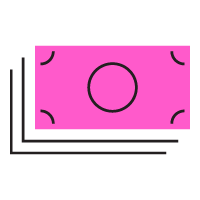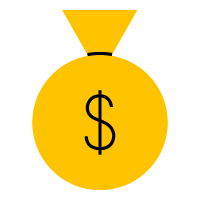Debt comes in many forms. You’ve probably used a credit card. Maybe you got a student loan to pay for your education or a home loan to buy a house. Some people use debt to pay bills or even to pay off other debt.
Debt can help you achieve your financial goals, but it can also burden you with higher payments that you can’t afford. To use debt well, you should know which types are productive and which aren’t, how to assess whether you have too much or not enough, and when and how to pay it down.
Whether debt is good or bad depends primarily on how you use the money. “Good” debt helps you increase your income or acquire assets. “Bad” debt is used to buy things that almost never appreciate in value, like cars, clothing, electronics, or other consumer goods or services. Carrying a balance on a credit card is also an example of bad debt.
Examples of good debt include student loans, business loans and mortgages — all things that one might expect to provide more value than the amount of debt.
It’s important to remember that even so-called good debt can be risky. A college degree might not enable you to land a high-paying job. Many start-up businesses never become profitable. Property values don’t always go up.
The decision to take on debt should be weighed carefully even if the debt is for a productive reason. Don’t borrow unless you have a clear plan for repayment.
If your debt keeps you awake at night, you may have more than you can handle. That’s a sign that you should pay down some or all of it before you borrow more.
Paying down debt can help you …
- Improve your standard of living
- Spend more on your needs and wants instead of on interest payments
- Become more financially secure
- Cut the number of monthly bill payments you have to track
- Boost your credit health
- Model good financial behavior for your kids
The basics
The first step to try to reduce your debt is to make a complete and accurate list of what you owe. For each debt, write down the name of the creditor, total amount you owe, minimum monthly payment, interest rate, and whether your payments have been late or on time.
The second step is to call each of your creditors to find out whether you can get a lower rate, longer repayment term or other relief. Even if the answer is no, you’ll have a better understanding of your situation and you’ll know your options.
Snowball or avalanche?
The third and fourth steps are to build a budget to find the maximum amount you can afford to pay every month toward your debt and decide how to prioritize your debt repayment. You should always make (at least) the minimum payment for every debt every month to help protect your credit scores.
Two popular debt repayment strategies are known as the snowball and the avalanche methods.
- Snowball — Make all the minimum payments for your various debts and then apply the rest of your available budget toward your smallest debt amount. When your smallest debt is paid off, start applying your available budget toward your next-smallest debt until that one is zeroed out, and so on. Disadvantage: the snowball method ignores interest rates, which can make paying down debt more expensive. But that might not be your most important concern.
- Avalanche — Make all your minimum payments and then apply the rest of your budget toward whichever debt has the highest interest rate. When that debt is paid off, use your available budget for whichever debt has the next-highest rate. Disadvantage: if your highest-rate debt takes many months or years to pay off, you won’t get the early win of paying off a smaller debt to help motivate you.
If you’re not sure which method to use, you can combine the two strategies. For example, you could pay off your smallest debt first for a quick win and then focus on your highest-rate debt for bigger savings.
Other options
If neither the snowball nor avalanche method is adequate for your situation, you might need to consider more-drastic options to reduce your debt. Here are four possibilities.
- Balance transfer card — Transferring your current credit card balances to a new card with a lower interest rate. You could save on interest if you follow the rules of the balance transfer offer and pay down the balance before the introductory interest rate (if available) expires. Though you may have to pay a balance transfer fee, typically around 3% of the amount transferred.
- Debt consolidation — Refinancing multiple debts with high interest rates into one loan with a lower rate. For example, you could get a personal loan and use the money to pay off your credit cards or other obligations. Debt consolidation could make it easier to pay down your debt and reduce your interest expense by making it so you only have to pay one bill every month — but your lender might charge an origination fee on the new loan.
- Credit counseling — Setting up a strict debt-management plan and negotiating with credit card issuers to try to get lower rates on your existing debt. You may have to pay a monthly fee to any credit counseling agency or company that you work with in exchange for their help. Be careful when selecting a debt counselor, as some unscrupulous ones exist.
- Debt settlement — Hiring a company or agency to try to negotiate partial forgiveness of some of your debt so that it’s more manageable for you. The Consumer Financial Protection Bureau generally does not recommend debt settlement.
When you’re weighing your options, it’s important to know that all of these strategies take time to complete. They could also affect your credit scores, and they may involve fees that wipe out any savings from a lower rate or debt settlement offer that you get.
Now that you’ve mastered the basics of how to use debt and when and how to pay it off, you’re ready to learn more about specific types of debt and might feel comfortable shopping for a new credit card or personal loan.
Though each type of debt has its own specific requirements, the essentials are the same. You should understand your financial goals and reasons for borrowing, know how much you owe, and have a smart, strategic plan to pay down your debt when it’s appropriate for you to do so. Make sure you’re familiar with the fundamentals of credit along with how to build and maintain it.






